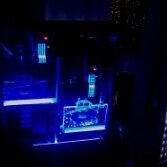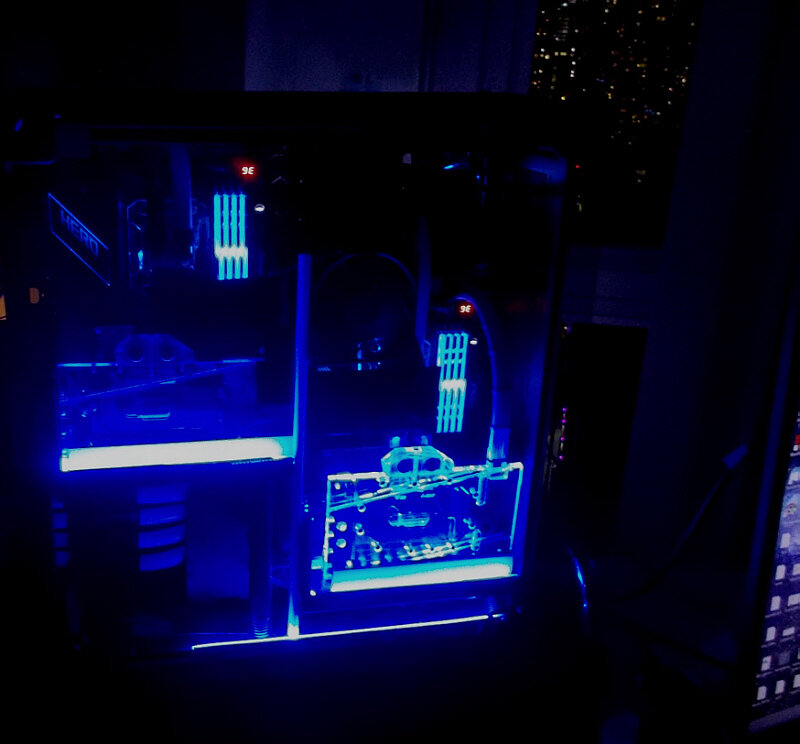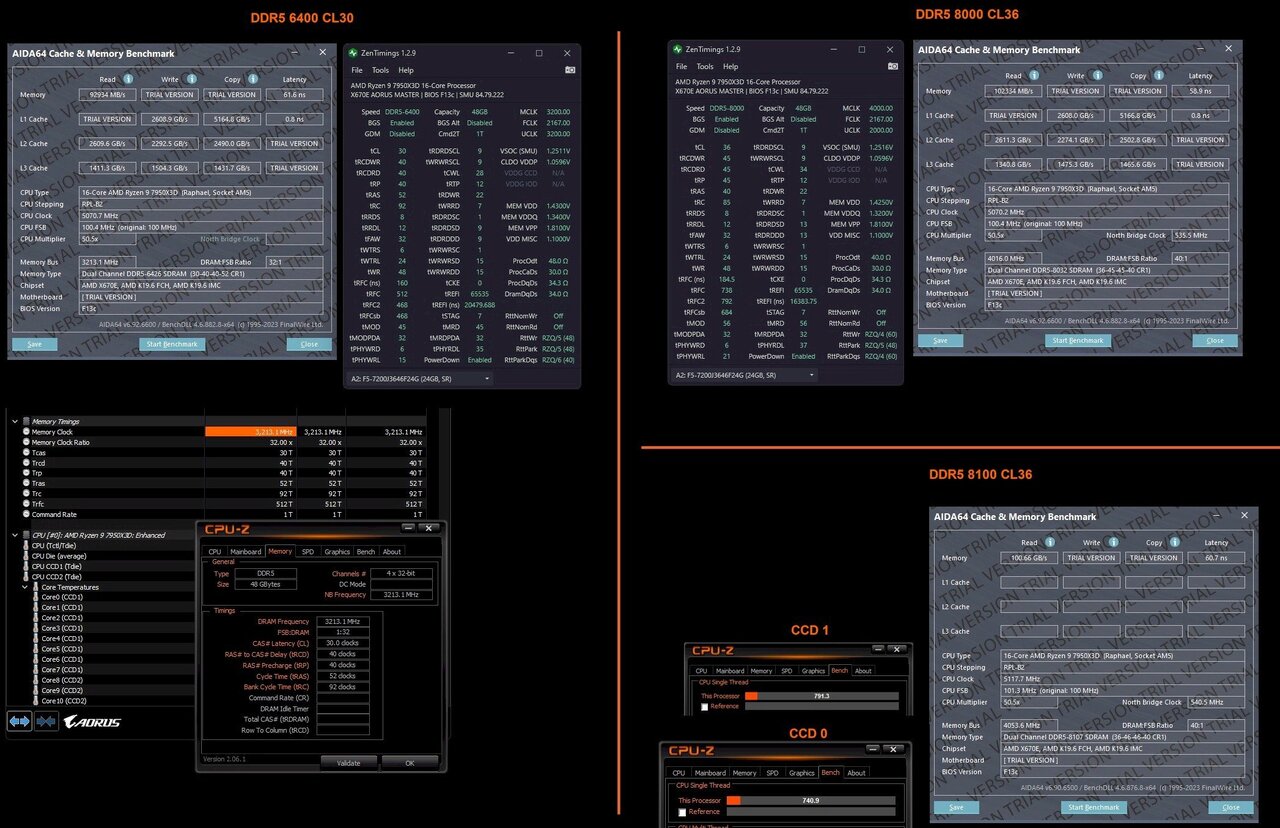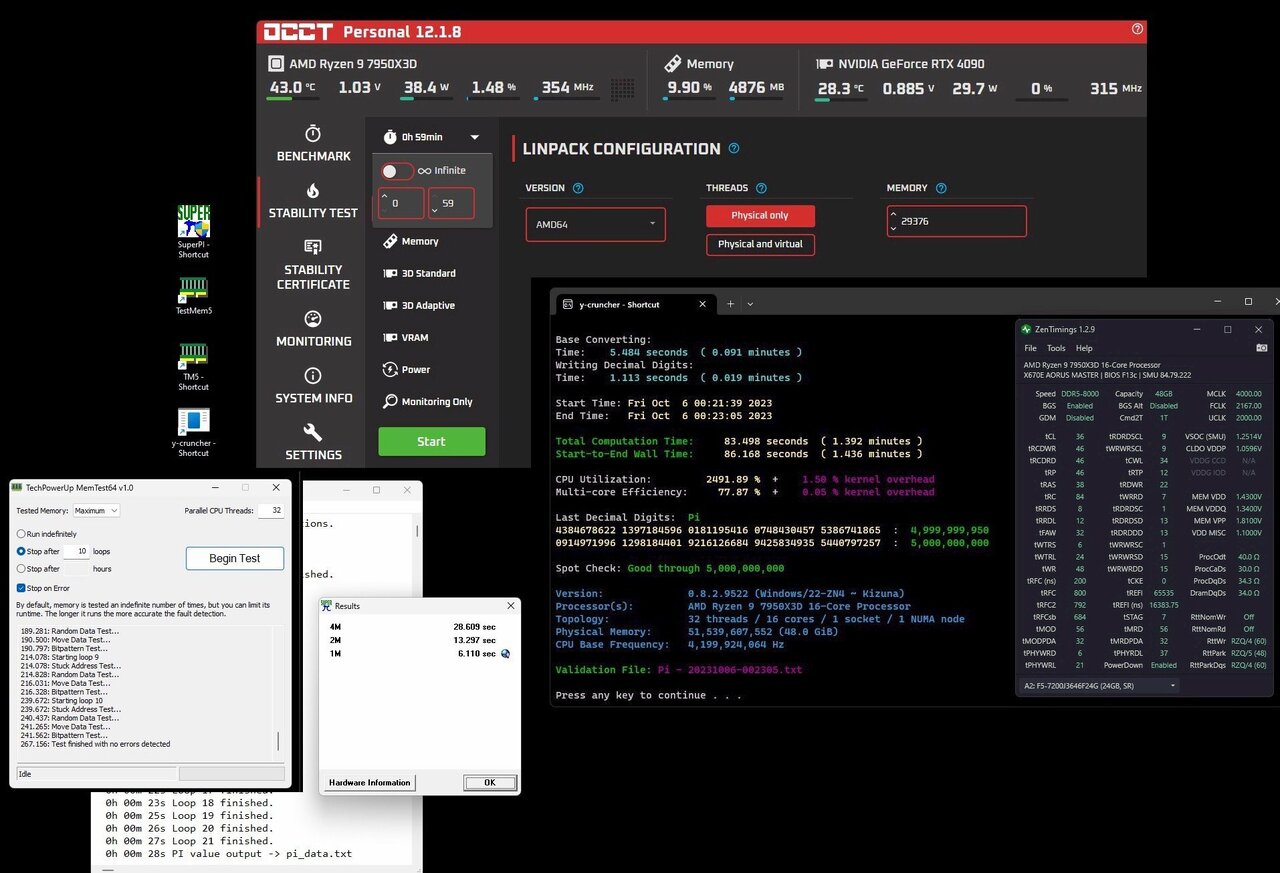Welcome to ExtremeHW
Welcome to ExtremeHW, register to take part in our community, don't worry this is a simple FREE process that requires minimal information for you to signup.
Registered users can:
- Start new topics and reply to others.
- Show off your PC using our Rig Creator feature.
- Subscribe to topics and forums to get updates.
- Get your own profile page to customize.
- Send personal messages to other members.
- Take advantage of site exclusive features.
- Upgrade to Premium to unlock additional sites features.
-
Posts
2,211 -
Joined
-
Last visited
-
Days Won
96 -
Feedback
0%
Content Type
Forums
Store
Events
Gallery
Profiles
Videos
Marketplace
Tutorials
Everything posted by J7SC_Orion
-
As @The Pook mentioned, the DDR5 scene has been much murkier to unkey as of late and 'id' than DDR4 was (I only used GSkill Samsung-B - GTZR on AM4, Intel CPUs). Re. DDR5, I have a new 2x24 GB GSkill M-die kit and couldn't be happier, whether running at > CL 36 8000 or CL 30 6400. Some earlier results I posted > here, > here and > here (1:1, 1:2). All that said, technically, my one and only DDR5 kit is Intel-spec RAM but XMP does show in the bios of my 670E Master / 7950X3D combo as an option and works fine. Same story before with my 5950X DDR4 CL14 4000 - Intel-spec RAM . If both the die designation and 'EXPO' are important to you, I would make a short list and contact for example GSkill and see if they will confirm (they should know, given serial numbers and production date)...
-
...fyi, there is also the 'old' M-die and the 'new' M-die differentiation...
-
Apart from the particular RAM sticks you have, a lot also has to do with the specific CPU's memory performance, and of course board topography and even bios version. I usually shortlist 2 - 3 potential settings via initial RAM tests, ie. 10 loops of TPU/Memtest64 error-free. Then I run each of the settings through some memory-sensitive benchies and games, and the 'winner' gets the long stress test treatment. If that doesn't make it through long tests w/o errors, the runner up gets a try... Without short-listing first, you might be doing this for weeks.
-
RAMitis for sure ...nice timings, and for MEM VDD of 1.55 V, I think you mentioned the extra cooling you added for the RAM. For the secondary and tertiary timings, I would go with Buildzoid's Hynix-A-die YT above. The 6400 I showed was using @kaliz 's timings to give you context. The 'new' M-die I run is very good for higher bandwidth (7600+, 1:2) but A-die is probably better for 1:1, given what I have read.
-
YouTube is being stingy, only 8K max on YT which my GPU does support
-
...what, no 16K HDR card ? How do you make it through the day ? ...and some 7 hrs of 4K / James Webb
-
...One of my fav Z790 boards, though it will have a short life span (Intel 14th gen) - one reason why I went the AM5 route recently ...btw, I do hope they fixed the Formula's 'corrosion issue' the Formula Z690 had, per Asus' site: "Developed in partnership with EK, the CrossChill VRM thermal solution on the ROG Maximus Z690 Formula uses a new electroless nickel plating. In certain configurations, this plating can break down, leading to galvanic corrosion inside the block's water channel."
-
I hope you folks don't develop RAM_eritis; I have seen that before, it is hideous For example, if you dream that you have to pass 666,667 % of RAM stress test xyz, call 911... Below on the left is a quick test with @kaliz 's suggested timings for CL30 6400 (using the same 2x24GB new M-die kit as before). I didn't translate all the voltages and timings but it is serving as a good basis for comparison to my regular 8000 settings...an irregular, non-optimized 8100 is also there for fun. I even have quite accidentally seen an even DDR5 8200 in Win 11 Pro, but it didn't last very long. The CPUZ items at the lower right just show single-thread performance with CCD 1 (speed) and CCD 0 (VCache).
-
My primary RAM test tools are TechPowerUp Memtest64 (lower left) OCCT, including the Linpack, and Y-Cruncher, with some SuperPi thrown in. Each can be varied re. loops / length all the way up to infinite (not that I would, but I could...). My version of TM5 has a severe security issue, probably because it was downloaded from a questionable site (did check first, though) --- it attacked Win 11 tpm
-
...I have exactly one DDR5 kit, that's the M-die. But here are some goodies for Hynix A-die on Ryzen 7000 from Buildzoid. Also check if he has done a newer vid on that combo (this came to mind first). This is in addition to the excellent advice @kaliz has been giving...
-
...I think higher fclk does make a difference on both bandwidth and latency, at least according to my tests and my setup. Lower primaries, especially CL, have a larger impact on latency, though. In any event, the key is to recognize when fclk is on the edge because it too can throw various errors before crashing outright. I know this because my system will run with fclk at 2200+, but errors sneak in, so I set it to 2167 and with the Aorus bonus boost that comes to 2175.
-
I also leave PowerDown enabled because the RAM is always busy doing something anyways with 2,300++ threads . I have GearDown disabled though. @ENTERPRISE @neurotix if you get to the point that RAM stress tests that loop over and over are fine for the first 10 times but fail at the eleventh or so, it is worthwhile checking the various DDR5 temps > that type of RAM really dislikes higher temps and starts throwing errors (I use 45 C as the cut-off). Another point is that my final 'fine-grain' DDR5 8000 tuning came down to CPU_VDDIO_Mem. At 1.33 V it works fine (same for DDR_VDDQ) and it has not given me a single WHEA ever, or other errors since I finished tuning the RAM. I got there by observing the number of memory errors it was showing in a given test loop early on, then made some small voltage adjustments...if the number of errors declined, I knew I was on the right track...rinse and repeat until no errors even over full-length RAM stress tests, y-cruncher et al. All in all, it was rather painless for me, not least as Buildzoid had tested very similar 2x24GB RAM on an Aorus mobo (650E Tachyon) just recently. My Aorus MAster 670E could take those values as a good starting position, and I actually ended up with (mostly) slightly lower voltages and tighter timings at 8000 than he showed. The real tricky bit was to run FCLK at 2167/75 and 8000 while staying within my voltage boundaries.
-
VDDP...1.05 V (shows as 1.0478 V in Zen timings)...it was one of the voltages I lowered a bit per earlier post; before it was at 1.06 V.
-
For DDR5 8000/+, I've set both to 1.0 V daily but don't exceed that even with bench settings at higher bclk / eclk.
-
...don't despair, gentlemen - setting up new memory usually is a big chase down a deep rabbit hole - it can get frustrating....but also be fun in a weird sort of way FYI, once I had locked in my daily setting shown before, I went back and slightly lowered several memory-related voltages (which weren't high to begin with) and also dialed back both LLCs to medium (fyi, more aggressive LLCs can help with RAM oc sometimes). This meant going through the short and long test suite again but in any case, the newer SK Hynix M-die 2x24GB kit really likes the higher speeds, up to CL36 8100+, though it will also do CL30 6000 at stock voltage (didn't even try a lower CL).
-
What about 7800 MHz on your board, noting that the Aorus boards are usually among the better ones for RAM oc'ing. In any event, 7800 MHz was fairly easily locked in with tight timings. I only went up to 8000 after I 'learned' the particulars about my mobo, CPU and specific RAM at 7800. Also, depending on your board, bclk can also get you there, but again subject to A LOT of testing. FYI, another thing to remember per earlier posts in this thread is that V_SOC adjustments work in opposite directions for higher FCLK vs higher RAM speed; you might want to try 2033 fclk and see what that brings re. top RAM speed.
-
...Keeping in mind that we have different boards and also that both CPU and RAM kits can have some variation, I would start with the less-tight settings shown on the left > here ...start with the stock RAM speeds and primaries per XMP setting, then work your way up. Also make sure that your FCLK is rock-solid; I typically lock that in after RAM tuning is done
-

GAME: Ban the Above User for a Reason - EHW Edition
J7SC_Orion replied to Simmons's topic in Chit Chat General
all_ban for disturbing this bandom's deep beauty sleep -
per Zen sheets, mine are single rank. After RAM and standard CPU, bclk+, and eclk+ profiles are all set now, I played around a bit with with Process Lasso , something @ENTERPRISE @neurotix and Co will also surely enjoy soon. It is more complex than Microsoft's XBox GameBar but ultimately gives better control. edit: ...did a few quick benchies; all that CPU & memory tuning is worth it:
-
...let's put it this way: This is actually XMP / Intel RAM micro-coded DDR5, and I have not touched either of those settings...






.thumb.png.c7dda22d5d67fc8669e5b9784e2c8126.png)
.thumb.png.22c3d1d479c112b1baf5a7c91e438d8d.png)
.thumb.png.24e2381697d96615c9ff7422b31cb039.png)
